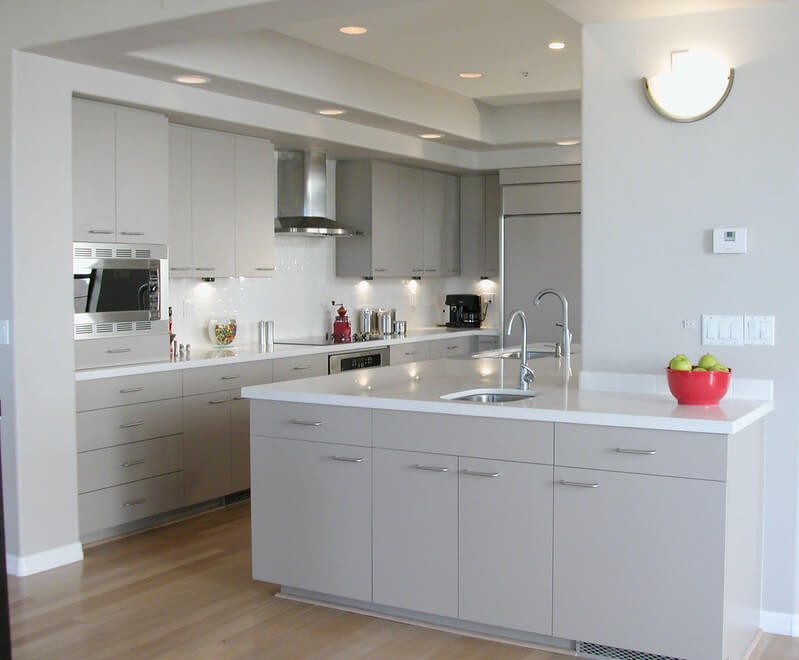If you’ve recently painted your cabinets and are looking for a way to protect the finish and add extra durability, polyurethane may be the perfect solution. Polyurethane is a clear finish applied over painted surfaces to provide a scratch-resistant, glossy finish. It is available in both oil-based and water-based formulations, each with its own set of benefits and drawbacks.
In this article, we’ll go over the steps for applying polyurethane on painted cabinets and some tips for getting the best results. Whether you’re looking to add some extra shine to your kitchen or just want to protect your newly painted cabinets, this guide has you covered.
Do I Need Polyurethane on Painted Cabinets?
Whether or not you need to apply polyurethane to your painted cabinets is largely a matter of personal preference and the specific needs of your project. Here are a few things to consider when deciding whether to use polyurethane on your painted cabinets:
- Durability: Polyurethane can help protect the paint on your cabinets and make it more resistant to scratches and wear. If your cabinets will see a lot of use and you want to ensure that they remain in good condition for as long as possible, polyurethane can be a good choice.
- Sheen: Polyurethane can give painted cabinets a glossy finish, adding a touch of shine and elegance to the room. If you want your cabinets to have a polished, professional look, polyurethane can help you achieve it.
- Ease of cleaning: Polyurethane can make it easier to clean your cabinets, as it creates a smooth, non-porous surface that is less prone to collecting dirt and grime. If you want your cabinets to be as easy to clean as possible, polyurethane may be a good choice.
Ultimately, deciding whether to use polyurethane on your painted cabinets will depend on your specific goals and needs. If you’re not sure whether polyurethane is the right choice for your project, you may want to consult with a professional or do some research to learn more about the pros and cons of this type of finish.
Want to apply with a spray gun and don’t know where to start? Best spray gun for poly buying guide and review
Picking the best Polyurethane for painted kitchen Cabinets
If you’re looking for the best polyurethane to use on your painted kitchen cabinets, there are a few things you should consider. First and foremost, you’ll need to decide between oil-based and water-based polyurethane. Oil-based polyurethane is known for its durability and ability to be sanded to a smooth finish, but it does tend to yellow over time and can have a strong smell. Water-based polyurethane dries more quickly and smells less, but it is not as durable as oil-based polyurethane and cannot be sanded as easily.
In addition to choosing between oil-based and water-based polyurethane, you’ll also need to consider the sheen of the finish. Polyurethane is available in a range of sheens, including matte, satin, semi-gloss, and high gloss. The sheen you choose will depend on your personal preference and the style of your kitchen. Matte finishes are subtle and understated, while high gloss finishes are more dramatic and reflective.
To help you find the best polyurethane for your painted kitchen cabinets, it can be helpful to read our product review and buying guide for the best top coat for painted kitchen cabinets.
Preparations before applying Polyurethane
Before applying polyurethane to your cabinets, it’s important to take a few preparatory steps to ensure the best possible results. Here are some key considerations:
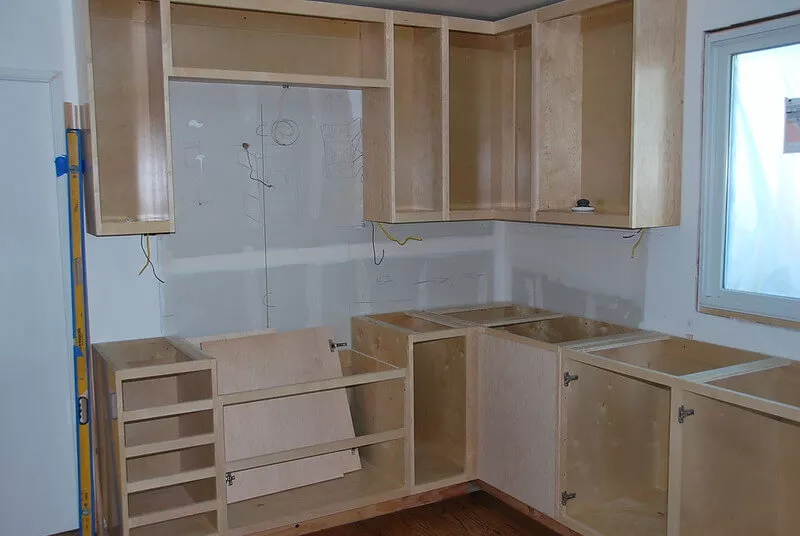
- Ventilation: Ensure the room or work area is well-ventilated to help dissipate the fumes from the polyurethane. This is especially important if you use an oil-based polyurethane, which can have a strong smell.
- Disassembly: Remove handles, drawers, and drawer fronts from the cabinets. This will make it easier to apply the polyurethane and ensure an even finish. Be sure to label the drawers so you can easily reassemble them later.
- Surface preparation: Ensure the cabinets are clean and dry before applying the polyurethane. The finish will seal any dirt or dust on the surface, so starting with a clean slate is important.
- Spill protection: Cover the floor around your work area to protect against spills or drips.
- Damage assessment: Check the surface of the cabinets for any blemishes that need to be addressed before applying the polyurethane. If there are grooved damages, apply a sealer to help prevent further peeling. For paint already peeling, sand off the loose particles and touch up with the same paint pigment as the rest of the cabinets.
Things to note
When it comes time to apply polyurethane to your painted cabinets, you can do a few things to ensure the best possible results. Here are some tips for a smooth, professional finish:
- Stir gently: Be careful when stirring the polyurethane to avoid generating bubbles. These bubbles can be difficult to remove and will show up in the final finish.
- Use a good brush: A good brush is essential for achieving a smooth finish when applying polyurethane. Synthetic bristle brushes are a good choice because they are less likely to leave brush strokes and can hold a lot of polyurethane at once, allowing you to glide smoothly along the surface.
- Work in small sections: Instead of covering the entire surface at once, work in small sections, applying a thin coat of polyurethane and overlapping your brushstrokes to avoid leaving brush marks.
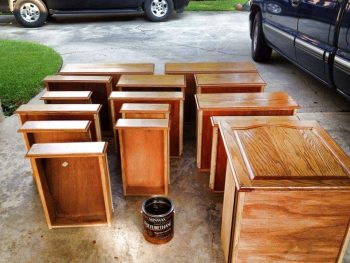
Steps to polyurethane painted Kitchen Cabinets.
- Apply the first coat: Dip the brush into the polyurethane, removing excess by dripping it back into the container. Begin applying the first coat, gliding the brush from one corner of the surface to the other. Avoid rubbing the brush back and forth, as this can create uneven bumps on the surface. If you miss a spot, don’t worry – you can fix it in the next coat.
- Sand the first coat: Once the first coat has dried, gently sand it with 220 to 400 grit sandpaper, taking care to sand along the wood grain. Remove any sanding residue and dust with a cloth.
- Apply the second coat: Make the second coat thicker than the first. This coat will help to level out any imperfections from the first coat. Repeat the process of gliding the brush from one corner of the surface to the other, overlapping your brushstrokes to avoid leaving brush marks.
- Allow the polyurethane to dry: Allow the polyurethane to dry completely according to the manufacturer’s instructions before using the cabinets. This can take anywhere from a few hours to a few days, depending on the type of polyurethane and the humidity and temperature of your home.
For Visual steps watch the video below
If another coat is needed, make sure to repeat the sanding step. However, if this is your last coat, let the cabinets rest for 48hrs before reassembling. In a short time, the desired amount of poly will become evident. If the poly is too thin, you will note dry spots on the finish while looking at different light angles. If the poly is too thick, it produces runs the sweet spot is right at the middle of the two extremes.
Polyurethane vs. Other Finishes for your Painted Cabinets
Polyurethane is just one of many types of finishes that can be used to protect and enhance painted cabinets. Some other options to consider include the following:
- Varnish: Varnish is a clear finish resistant to moisture and wear. It is available in a range of sheens and can be applied over water-based or oil-based paint.
- Shellac: Shellac is a natural finish made from the lac bug’s secretions. It dries quickly and has a natural amber color. Shellac is relatively easy to apply and can be buffed to a high gloss finish.
- Acrylic varnish: Acrylic varnish is a water-based finish that is easy to clean up and has low levels of volatile organic compounds (VOCs). It dries to a hard, durable finish and is available in a range of sheens.
- Lacquer: Lacquer is a fast-drying finish that can be applied in thin layers to build up a glossy finish. It is resistant to water and wear but can be prone to yellowing over time.
Frequently Asked Questions about Kitchen Cabinets
should you poly over painted cabinets?
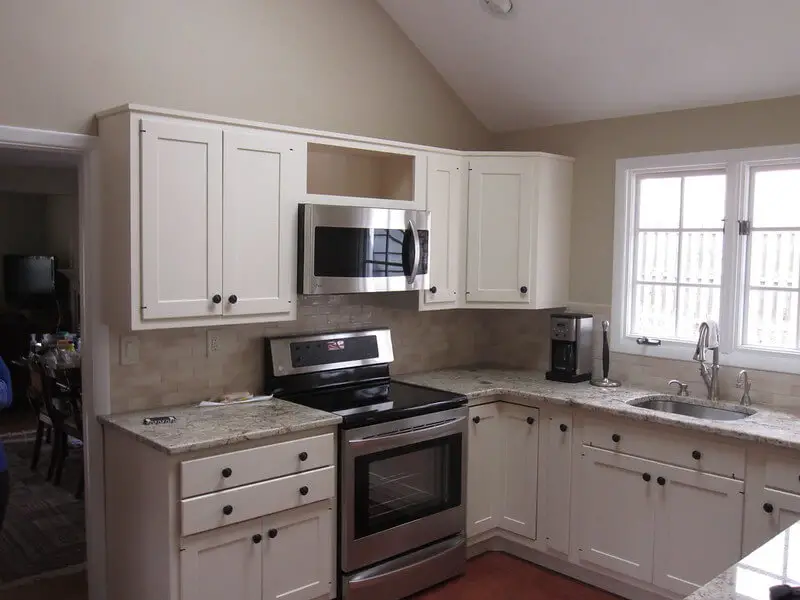
Polyurethane is a good choice for kitchen cabinets because it helps protect the wood from moisture damage and wear and tear, which can be especially important in a room with high humidity like the kitchen. It also helps keep the cabinets looking new and extends their lifespan. Water-based polyurethane is a good option because it is easy to clean with just water and soap. It can be applied to unfinished wood or over-painted surfaces.
What is the most durable kitchen cabinet finish?
Waterborne UV finishes are considered the most durable for kitchen cabinets. These products are eco-friendly and dry quickly, protecting the wood and the health of those using the cabinets. However, it is always a good idea to apply a top coat of polyurethane varnish to any finish you choose for your kitchen cabinets, as it can provide extra protection and durability.
Should cabinets be gloss or satin?
Satin finishes are better for touch-ups because they do not highlight imperfections as much as semi-gloss finishes do. This makes satin finishes a good choice for concealing or obscuring blemishes or recently repaired areas. However, semi-gloss finishes are easier to clean, so you may also want to consider this factor.
What is better, polyurethane or Polycrylic?
Polyurethane is more durable and provides better adhesion than Polycrylic, which is intended for use on interior surfaces like cabinets and furniture. However, Polycrylic may not be suitable for use on kitchen and bathroom cabinets, as these areas are prone to moisture and may require a more durable finish like polyurethane.
Should I polyurethane my painted cabinets?
If you have applied durable paint to your cabinets, you may not need to apply a polyurethane finish. However, if you have used less durable paint, applying a light coat of polyurethane can help prolong the life of your cabinets, especially in high-moisture areas like the kitchen. The polyurethane acts as an extra layer of protection and can be applied when you don’t trust the existing protection, such as the paint, to adequately protect the wood.
Summary: polyurethane over paint cabinets
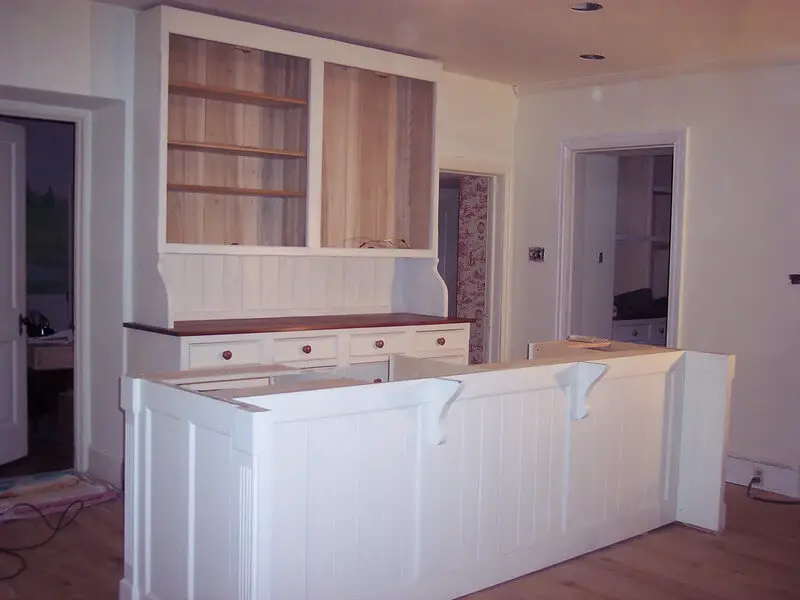
In conclusion, applying polyurethane to painted cabinets can provide extra protection and durability, as well as a glossy finish. Whether or not you choose to use polyurethane will depend on your personal preferences and the specific needs of your project. When selecting a polyurethane for your cabinets, consider the type (water-based or oil-based), the sheen, and the specific requirements of your paint.
Proper preparation, including sanding and cleaning the surface, is key to ensuring a smooth and successful application of polyurethane. Following the steps and tips outlined in this article can help you achieve professional-looking results when applying polyurethane to your painted cabinets.

